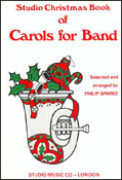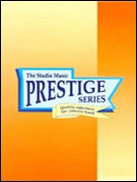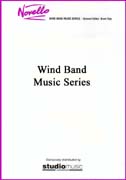Results
-
 £4.95
£4.95Carols for Band (Oboe) - Sparke, Philip
Designed to be playable by any combination from quartet to full brass band, wind band or orchestra, the arrangements in this book with provide a practical solution to all your carolling needs. Parts are divided into Soprano, Alto, Tenor and Bass so that any suitable instrumentation will sound well, providing an equal balance of players per voice is maintained. The carols are printed in alphabetical order so they are easy to find, and comprehensively indexed under both first line and name of tune.Instrumentation is as follows: Brass BandWind BandStringsSopranoEb Soprano CornetSolo Bb CornetBb Repiano & Flugel1st Flute & Piccolo2nd FluteOboe1st Bb Clarinet1st Bb Trumpet/Cornet1st ViolinAlto2nd & 3rd Bb CornetSolo Eb Horn1st Bb Trombone2nd & 3rd Bb ClarinetsEb Alto Saxophone2nd Bb Trumpet/Cornet1st F Horn2nd ViolinTenor1st & 2nd Eb Horns1st & 2nd Bb Baritones2nd Bb Trombone1st Bb EuphoniumEb Alto ClarinetBb Tenor Saxophone2nd F Horn1st & 2nd TrombonesViolaBassBass Trombone2nd Bb EuphoniumEb BassBb BassBassoonBb Bass ClarinetEb Baritone SaxophoneBass TromboneEuphoniumTubaCello/BassTitles included:Angels from the Realms of GloryAs with Gladness Men of OldAway in a MangerBrightest and BestChristians AwakeCoventry CarolDeck the HallsDing Dong, Merrily on HighFirst NowellGod Rest ye Merry, GentlemenGood King WenceslasHark the Glad SoundHark, the Herald Angels SingHolly and the IvyI Saw Three ShipsIn Dulci JubiloIn the Bleak Mid-WinterInfant HolyInfant KingIt Came Upon a Midnight ClearJingle BellsLo, He Comes with Clouds DescendingLove Came Down at ChristmasO Come, All ye FaithfulO Come, O Come, EmmanuelO Little Town of BethlehemOf the Father's Love BegottenOnce in Royal David's CitySans Day CarolSee Amid the Winter's SnowSilent NightSussex CarolThou Didst Leave Thy ThroneUnto Us is Born a SonWe Wish You a Merry ChristmasWhile Shepherds Watched
Estimated dispatch 7-14 working days
-
 £4.95
£4.95Carols for Band (2nd Flute) - Sparke, Philip
Designed to be playable by any combination from quartet to full brass band, wind band or orchestra, the arrangements in this book with provide a practical solution to all your carolling needs. Parts are divided into Soprano, Alto, Tenor and Bass so that any suitable instrumentation will sound well, providing an equal balance of players per voice is maintained. The carols are printed in alphabetical order so they are easy to find, and comprehensively indexed under both first line and name of tune.Instrumentation is as follows: Brass BandWind BandStringsSopranoEb Soprano CornetSolo Bb CornetBb Repiano & Flugel1st Flute & Piccolo2nd FluteOboe1st Bb Clarinet1st Bb Trumpet/Cornet1st ViolinAlto2nd & 3rd Bb CornetSolo Eb Horn1st Bb Trombone2nd & 3rd Bb ClarinetsEb Alto Saxophone2nd Bb Trumpet/Cornet1st F Horn2nd ViolinTenor1st & 2nd Eb Horns1st & 2nd Bb Baritones2nd Bb Trombone1st Bb EuphoniumEb Alto ClarinetBb Tenor Saxophone2nd F Horn1st & 2nd TrombonesViolaBassBass Trombone2nd Bb EuphoniumEb BassBb BassBassoonBb Bass ClarinetEb Baritone SaxophoneBass TromboneEuphoniumTubaCello/BassTitles included:Angels from the Realms of GloryAs with Gladness Men of OldAway in a MangerBrightest and BestChristians AwakeCoventry CarolDeck the HallsDing Dong, Merrily on HighFirst NowellGod Rest ye Merry, GentlemenGood King WenceslasHark the Glad SoundHark, the Herald Angels SingHolly and the IvyI Saw Three ShipsIn Dulci JubiloIn the Bleak Mid-WinterInfant HolyInfant KingIt Came Upon a Midnight ClearJingle BellsLo, He Comes with Clouds DescendingLove Came Down at ChristmasO Come, All ye FaithfulO Come, O Come, EmmanuelO Little Town of BethlehemOf the Father's Love BegottenOnce in Royal David's CitySans Day CarolSee Amid the Winter's SnowSilent NightSussex CarolThou Didst Leave Thy ThroneUnto Us is Born a SonWe Wish You a Merry ChristmasWhile Shepherds Watched
Estimated dispatch 7-14 working days
-
 £4.95
£4.95Carols for Band (1st Flute & Piccolo) - Sparke, Philip
Designed to be playable by any combination from quartet to full brass band, wind band or orchestra, the arrangements in this book with provide a practical solution to all your carolling needs. Parts are divided into Soprano, Alto, Tenor and Bass so that any suitable instrumentation will sound well, providing an equal balance of players per voice is maintained. The carols are printed in alphabetical order so they are easy to find, and comprehensively indexed under both first line and name of tune.Instrumentation is as follows: Brass BandWind BandStringsSopranoEb Soprano CornetSolo Bb CornetBb Repiano & Flugel1st Flute & Piccolo2nd FluteOboe1st Bb Clarinet1st Bb Trumpet/Cornet1st ViolinAlto2nd & 3rd Bb CornetSolo Eb Horn1st Bb Trombone2nd & 3rd Bb ClarinetsEb Alto Saxophone2nd Bb Trumpet/Cornet1st F Horn2nd ViolinTenor1st & 2nd Eb Horns1st & 2nd Bb Baritones2nd Bb Trombone1st Bb EuphoniumEb Alto ClarinetBb Tenor Saxophone2nd F Horn1st & 2nd TrombonesViolaBassBass Trombone2nd Bb EuphoniumEb BassBb BassBassoonBb Bass ClarinetEb Baritone SaxophoneBass TromboneEuphoniumTubaCello/BassTitles included:Angels from the Realms of GloryAs with Gladness Men of OldAway in a MangerBrightest and BestChristians AwakeCoventry CarolDeck the HallsDing Dong, Merrily on HighFirst NowellGod Rest ye Merry, GentlemenGood King WenceslasHark the Glad SoundHark, the Herald Angels SingHolly and the IvyI Saw Three ShipsIn Dulci JubiloIn the Bleak Mid-WinterInfant HolyInfant KingIt Came Upon a Midnight ClearJingle BellsLo, He Comes with Clouds DescendingLove Came Down at ChristmasO Come, All ye FaithfulO Come, O Come, EmmanuelO Little Town of BethlehemOf the Father's Love BegottenOnce in Royal David's CitySans Day CarolSee Amid the Winter's SnowSilent NightSussex CarolThou Didst Leave Thy ThroneUnto Us is Born a SonWe Wish You a Merry ChristmasWhile Shepherds Watched
Estimated dispatch 7-14 working days
-
 £19.95
£19.95Carols for Band (Piano Conductor Score) - Sparke, Philip
Designed to be playable by any combination from quartet to full brass band, wind band or orchestra, the arrangements in this book with provide a practical solution to all your carolling needs. Parts are divided into Soprano, Alto, Tenor and Bass so that any suitable instrumentation will sound well, providing an equal balance of players per voice is maintained. The carols are printed in alphabetical order so they are easy to find, and comprehensively indexed under both first line and name of tune.Score, Timpani and Percussion parts are available separately.Instrumentation is as follows: Brass BandWind BandStringsSopranoEb Soprano CornetSolo Bb CornetBb Repiano & Flugel1st Flute & Piccolo2nd FluteOboe1st Bb Clarinet1st Bb Trumpet/Cornet1st ViolinAlto2nd & 3rd Bb CornetSolo Eb Horn1st Bb Trombone2nd & 3rd Bb ClarinetsEb Alto Saxophone2nd Bb Trumpet/Cornet1st F Horn2nd ViolinTenor1st & 2nd Eb Horns1st & 2nd Bb Baritones2nd Bb Trombone1st Bb EuphoniumEb Alto ClarinetBb Tenor Saxophone2nd F Horn1st & 2nd TrombonesViolaBassBass Trombone2nd Bb EuphoniumEb BassBb BassBassoonBb Bass ClarinetEb Baritone SaxophoneBass TromboneEuphoniumTubaCello/BassTitles included:Angels from the Realms of GloryAs with Gladness Men of OldAway in a MangerBrightest and BestChristians AwakeCoventry CarolDeck the HallsDing Dong, Merrily on HighFirst NowellGod Rest ye Merry, GentlemenGood King WenceslasHark the Glad SoundHark, the Herald Angels SingHolly and the IvyI Saw Three ShipsIn Dulci JubiloIn the Bleak Mid-WinterInfant HolyInfant KingIt Came Upon a Midnight ClearJingle BellsLo, He Comes with Clouds DescendingLove Came Down at ChristmasO Come, All ye FaithfulO Come, O Come, EmmanuelO Little Town of BethlehemOf the Father's Love BegottenOnce in Royal David's CitySans Day CarolSee Amid the Winter's SnowSilent NightSussex CarolThou Didst Leave Thy ThroneUnto Us is Born a SonWe Wish You a Merry ChristmasWhile Shepherds Watched
Estimated dispatch 7-14 working days
-
 £68.00
£68.00'Twas The Night Before - Shaffer, David
With a fanfare emphasis on the brass and percussion section, David Shaffer has cleverly woven 4 classic Christmas tunes into a high-energy medley of pure enjoyment for your students and your audiences. Perfect for an opening holiday fanfare or a dramatic closer to your program, the optional antiphonal brass will make this arrangement a sure hit for your holiday program.
Estimated dispatch 7-14 working days
-
 £67.32
£67.32Andromeda
Exciting brass flourishes introduce the lyrical main theme stated by the woodwinds. This motive is woven throughout the piece in contrasting styles and musical colors. A bold middle section creates a dialogue between the woodwinds and solo brass instruments, leading to a powerful coda bringing the entire work to dramatic conclusion. Excellent for contest, festival any programming occasion.
Estimated dispatch 7-14 working days
-
 £19.95
£19.95CAMBRIAN SUITE (Prestige Concert Band Extra Score) - Ball, Michael
Extra Score. This suite - originally a brass band work - was commissioned jointly by the Black Dyke Band and the Brass Band Heritage Trust. The composer later made this version for concert band. The work is intended to be played without a break but divides naturally into three sections. Each section is based upon a traditional Welsh melody treated in free variation manner, respectively Gwyr Harlech (Men of Harlech), Suo-Gan (Cradle Song) and Codiad Yr Hedydd (The Rising of the Lark). There is a momentary reference to Yr Deryn Pur (The White Bird) at the end of the second section. (Grade 4) Performance time: 12:00 Recorded on Polyphonic QPRM152D MOSAIC: Great British Music Vol. 13
Estimated dispatch 7-14 working days
-
 £99.95
£99.95CAMBRIAN SUITE (Prestige Concert Band Set) - Ball, Michael
Score and Parts. This suite - originally a brass band work - was commissioned jointly by the Black Dyke Band and the Brass Band Heritage Trust. The composer later made this version for concert band. The work is intended to be played without a break but divides naturally into three sections. Each section is based upon a traditional Welsh melody treated in free variation manner, respectively Gwyr Harlech (Men of Harlech), Suo-Gan (Cradle Song) and Codiad Yr Hedydd (The Rising of the Lark). There is a momentary reference to Yr Deryn Pur (The White Bird) at the end of the second section. (Grade 4) Performance time: 12:00 Recorded on Polyphonic QPRM152D MOSAIC: Great British Music Vol. 13
Estimated dispatch 7-14 working days
-
 £189.95
£189.95CANYONS (Novello Symphonic) - McCabe, John
Score & Parts. Canyons is a response to the imposing landscape of the American South West, an exploration of musical ideas. The piece falls into four main sections. Following a build-up in the brass and woodwind, there is a slowish first section with massive chords, percussive pounding and some contrapuntal development of the work's main thematic idea. This is followed by a brief scherzo and then a slow movement which again derives from chordal material and another contrapuntal development. The fourth section is an extended Allegro Vivace, dominated by a dance-like theme introduced by the trumpets and an important motif heard at the start by the brass and percussion. After the final climax, the Adagio epilogue leads the music to a quiet close, the solo piccolo restating the cornet figure heard at the opening of the work. (Grade 4.5) Duration: 15 mins. Recorded on QPRM127D GUILDHALL SYMPHONIC WIND ENSEMBLE
Estimated dispatch 7-14 working days
-
 £37.95
£37.95CANYONS (Novello Symphonic) Extra Score - McCabe, John
Extra Score. Canyons is a response to the imposing landscape of the American South West, an exploration of musical ideas. The piece falls into four main sections. Following a build-up in the brass and woodwind, there is a slowish first section with massive chords, percussive pounding and some contrapuntal development of the work's main thematic idea. This is followed by a brief scherzo and then a slow movement which again derives from chordal material and another contrapuntal development. The fourth section is an extended Allegro Vivace, dominated by a dance-like theme introduced by the trumpets and an important motif heard at the start by the brass and percussion. After the final climax, the Adagio epilogue leads the music to a quiet close, the solo piccolo restating the cornet figure heard at the opening of the work. (Grade 4.5) Duration: 15 mins. Recorded on QPRM127D Great British Music for Wind Band Vol.4 (Guildhall Symphonic Wind Ensemble, Peter Gane)
Estimated dispatch 7-14 working days
